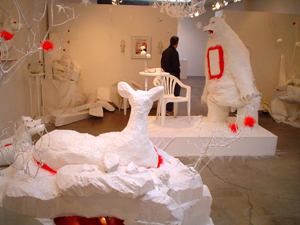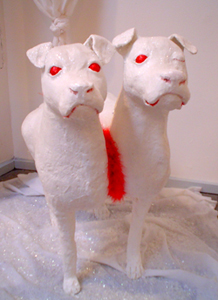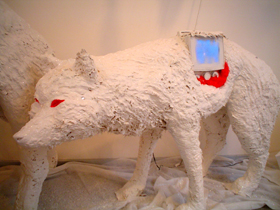
|
||
|
Portland art blog + news + exhibition reviews + galleries + contemporary northwest art
|
||
Love in the Wild, Vicki Lynn Wilson at Blackfish  An installation of new work by Vicki Lynn Wilson at the Blackfish Gallery entitled Love in the Wild is fraught with complex tension. The work shifts easily though inexplicably between silly fairy tale narrative and images of predatory violence, while always returning to a single generative nexus: the American living room. Wilson's cold, snowy, sparkly myth-scape is an allegorical environment distantly related to the frozen despair of Narnia under the influence of the White Queen: forever winter without Christmas. Wilson prefers improvisation to rational narrative and uses low materials such as toys and Styrofoam. She allows incongruities of scale and placement to freely proliferate. Wilson's nuanced detail and mischievous humor freely generate incongruity. One of the best small moments of the show takes place when a snow covered toy shark somehow ends up in a tiny bird's nest. 
As in the White Queen's Narnia, The freezing in Love in the Wild applies to time as well as temperature. Time no longer seems to progress, but eddies and compounds idly. The interaction of prey and predators (which also seem formed from glittering snow) becomes confounded in the absence of a timeline. Animals divide and replicate constructively, the aura of predatory menace becomes detached from a specific event and diffuses into the atmosphere itself. A hunting dog seems to divide through mitosis, becoming a diploid aggregate, the halves seamed together with bright red fabric scar tissue. In fact red is the only color present in the gallery besides white. The installation on the whole becomes a tableau of stilled artic violence and magical surgeries. But Wilson takes great pains to let us know that this mythology is not pure abstract fantasy, but rather is tightly bound to familiar experience; specifically, to American Experience. 
The chest of the maladroit polar bear opens to reveal that it is in fact a mini-fridge. The circling plaster wolves have televisions hissing static embedded in their sides. Arctic end-tables and white carnations abound, and framed portraits hang on the walls. It is a domestic interior transformed by a private mythology of Arctic Violence. Since the events of September 11, 2001, there has emerged an aesthetic of vulnerability, which, as Jeff has pointed out, has perhaps become a trend. This aesthetic is best symbolized by a deer shot with arrows, and serves as an articulation of an adolescent mythology of powerlessness. Expression of this aesthetic mainly takes the form of drawings and galleries began showing work which could be described as adolescent doodling on notebook paper. I think the observation that the emerging aesthetic of vulnerability created an easily repeatable trend is to the point, but I think there is much more here to be examined. It is often noted that art provides what is lacking from the culture at large. Think of how the austerity of minimalism culminated during the sensory excess of the 60's, and now, after the millennium, in a culture that has become disciplined, health-conscious and materialistic, psychedelia is re-emerging in the visual arts (represented best by Assume Vivid Astro Focus). The idea that art replaces what is missing from culture at large gives a defense of the aesthetic of vulnerability. What the culture at large wouldn't admit is that we felt helpless and scared. The only aesthetic responses available were the ass-kicking anthems of Tobey Keith, and the political response was immediate reprisal. The work of artists with programs that deviated only slightly from the official aesthetic/ political program (such as the Dixie chicks) was the subject of swift iconoclasm. But there was something that needed to be communicated; something that wasn't addressed by the official program. What happened has a surprising correlation with the German Expressionists under the aesthetic program of the Nazis; a state the Expressionists called the "Internal Emigration". This is the idea that in a culture that offers the individual little or no means of expression, the individual begins to turn inward, to emigrate to the free country inside. I do not mean to say that Post 9-11 America's aesthetic program in any way compares to the severity of a Fascist State, but the fact remains that Post 9-11 America DOES have an aesthetic program. Up until 2001, aesthetic programs were more mercurial, and furthermore, defined by the art world, not the administration. And it is not going too far to point out, that for perhaps the first time in its history, America has become a Theocracy! Given, this Theocracy does represent the views of the religious majority, but it has also served to alienate those with alternative outlooks (artists for example). What it has done in the art world is made the exploration of Myth (with its personal and religious implications) of the utmost importance! Perhaps the aesthetic of vulnerability, with its wounded deer drawn on notebook pages expressed this in a way that was too feeble. The aesthetic of vulnerability was naturally overly twee, and that was part of the point! It had no presence as artwork, it was easily brushed aside and could be easily destroyed. Wilson gives an expansion point for the aesthetic of vulnerability. Her work retains all of the sweetness and adolescent immediacy of Post 9-11 art. Wilson injects these established ideals with a threatening complexity. Love in the Wild expresses themes of menace and vulnerability as well as adolescent awkwardness in a way that is more present, more substantial than what we've come to expect from the trend. The work is somehow both sterile and glitzy, and retains the innocence and violence of the best Fairy Tales (such as source versions of the Brothers Grimm). Wilson's generation of a personal mythos that is complex and immoral is an act of aesthetic sedition in a Theocratic Nation whose morally based decisions lead to preemptive war. It is nice to see that the aesthetic of vulnerability is gaining some depth, and may in fact turn out to be more than vacuous doodling. In addition, it is rare to see high art address issues that are primarily spiritual and emotional in nature, and Wilson's work is a courageous foray into this realm, and a welcome relief from visual art as an overly cerebral experience. Vicki Lynn Wilson • Love in the Wild • February 28th - April 1st • Blackfish Gallery • 420 NW 9th Avenue • Portland, OR, 97209 • Posted by Isaac Peterson on March 20, 2006 at 23:35 | Comments (0) Comments Post a comment Thanks for signing in, . Now you can comment. (sign out)
(If you haven't left a comment here before, you may need to be approved by
the site owner before your comment will appear. Until then, it won't appear
on the entry. Thanks for waiting.)
|
| s p o n s o r s |
 |
 |
 |
 |
 |
 |
 |
 |
 |
 |
 |
 |
 |
 |
 |
 |

|
Site Design: Jennifer Armbrust | • | Site Development: Philippe Blanc & Katherine Bovee | |

